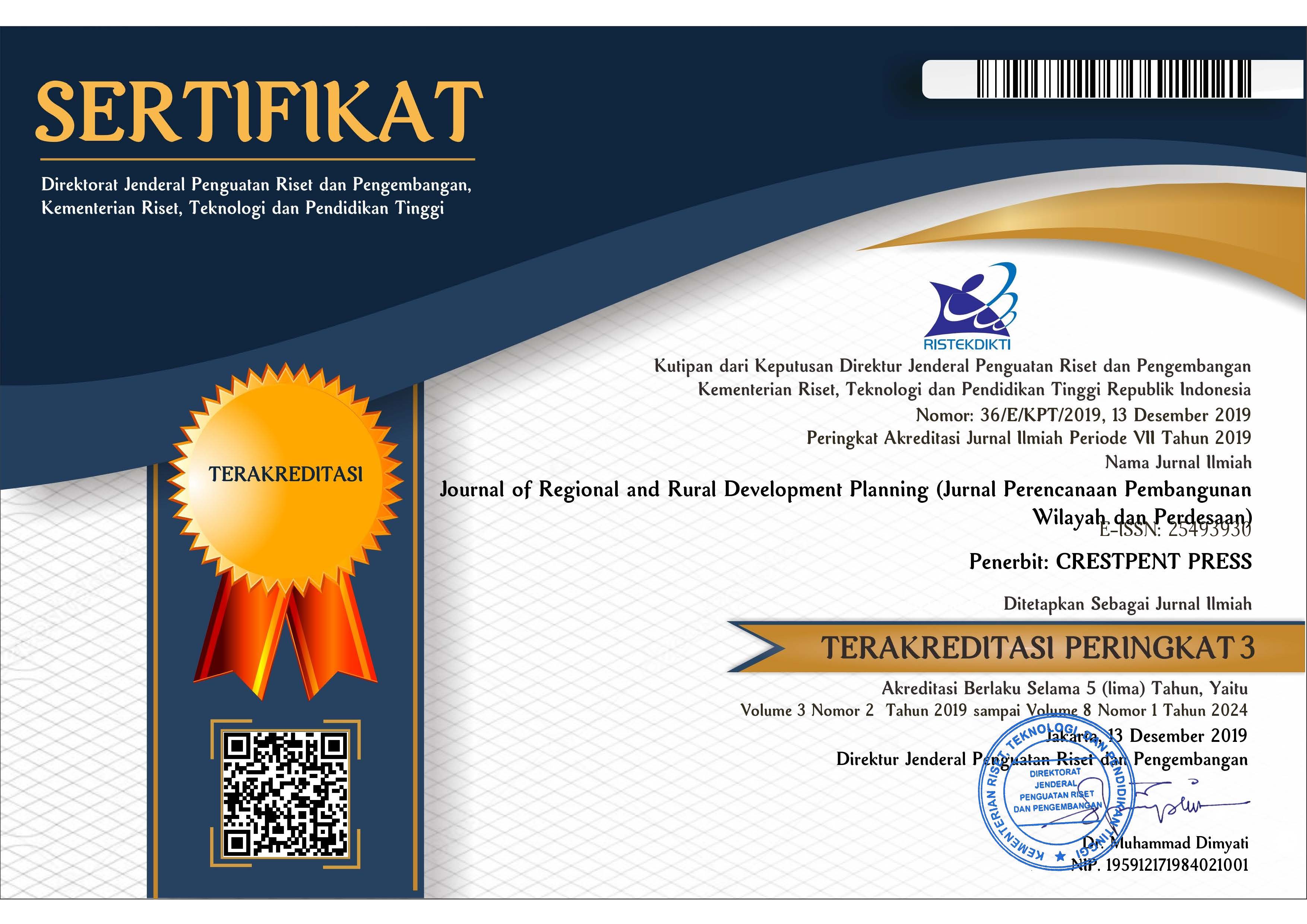Ancaman Konversi Lahan Sawah Terhadap Kecukupan Beras di Kabupaten Musi Rawas
Abstract
Rice production in 2019 decreased by 2.63 million tons or 7.75 percent compared to 2018, exacerbated by the increasingly massive conversion of agricultural land. One of the areas threatened by land conversion is Musi Rawas Regency in South Sumatra Province. This study aims to analyze changes in land use in 2000, 2010, 2020 and paddy fields for rice sufficiency in Musi Rawas Regency. The method used is Cellular Automata-Markov (CA-Markov), analysis of the surplus-deficit food balance, and paddy fields overlaying the spatial plan. Based on the results of the analysis, there was a change in land use in Musi Rawas Regency between 2000 to 2020, an increase in the area of plantation land by 128,867.74 ha. This increase is largely the result of conversion of paddy fields. The results of the calculation of the predicted demand for rice in 2030 show that in total there will be a rice deficit of -16,511 tons. It is predicted that there will be a rice deficit due to the decrease in the area of paddy fields which is affected by changes in land use from paddy fields to non-paddy fields. The suitability of existing paddy fields with the 2010 to 2030 RTRW shows an area of 7,598.73 ha of actual paddy fields in 2020 is suitable, 3,057.27 ha is not suitable. The incompatibility of paddy fields in 2020 with the RTRW can be input into the revision of the RTRW that will be carried out by the Musi Rawas Regency government, especially on the spatial pattern of paddy fields.
References
Adhiatma, R. (2020). Perencanaan Pengembangan Lahan Sawah untuk Mempertahankan Kecukupan Beras di Kabupaten Lampung Selatan [tesis]. Bogor (ID): Institut Pertanian Bogor.
Alkaradaghi, K., Ali SS., Al-Ansari N, & Laue J. (2018). Evaluation of land use & land cover change using multi-temporal landsat imagery: a case study Sulaimaniyah Governorate, Iraq. J Geogr Inf Syst. 10(03):247–260. doi:10.4236/jgis.2018.103013.
Asra, R., Mappiasse, MF., & Nurnawati, AA. (2020). Penerapan Model CA-Markov Untuk Prediksi Perubahan Penggunaan Lahan Di Sub-DAS Bila Tahun 2036. Jurnal Ilmu Pertanian. 5(1).
Bhandari H., & Mishra AK. (2018). Impact of demographic transformation on future rice farming in Asia. Outlook on Agriculture. 47(2) 125-132.
Bishwajit, G., Sarker S., Kpoghomau MA., Gao H, Jun L, Yin D, & Ghosh S. (2013). Self-sufficiency in rice and food security: A South Asian perspective. Agriculture Food Security. 2(1): 1–6. DOI: 10.1186/2048-7010-2-10.
[BPS Kab. Musi Rawas] Badan Pusat Statistik Kabupaten Musi Rawas. (2019). Kabupaten Musi Rawas dalam Angka 2019. Musi Rawas (ID): BPS Kabupaten Musi Rawas.
[BPS Indonesia] Badan Pusat Statistik Indonesia. (2020). Luas Panen dan Produksi Padi di Indonesia 2019 Hasil Survei Kerangka Sampel Area (KSA). Indonesia (ID): BPS Indonesia.
Chen, J., Gong, P., He, C., Luo, W., Tamura, M., & Shi P. (2002). Assessment of the urban development plan of Beijing by using a CA-based urban growth model. Photogrammetric engineering & remote sensing. 68(10): 1063-1071.
Danoedoro, P. (1996). Pengolahan Citra Difital: Teori dan Aplikasinya dalam Bidang Penginderaan Jauh. Yogyakarta: Fakultas Geografi UGM.
Deep, S., & Saklani, A. (2014). Urban Sprawl Modeling Using Cellular Automata. The Egyptian Journal of Remote Sensing and Space Sciences. 17:179–187.
Hartoko, S. (2018). Analisis Perubahan Penggunaan Lahan dan Arahan Penyempurnaan Rencana Tata Ruang Wilayah Kabupaten Pelalawan, Provinsi Riau [tesis]. Bogor (ID): Institut Pertanian Bogor.
Jaiswal, JK., & Verma., N. (2013). The Study of The Land Use/land Cover in Varanasi District Using Remote Sensing and GIS. Jurnal Trans. J. Indian Inst Geograph.35, 201-208.
Jensen, JR. (2005). Introductory Digital Image Processing: A Remote sensing Perspective. Prentice Hall. New Jersey.
Kementerian Pertanian. (2019). Statistik Lahan Pertanian Tahun 2014-2018. Jakarta (ID): Pusat Data dan Informasi Pertanian Kementerian Pertanian.
Lillesand, TM., & Kiefer, RW. (1997). Penginderaan Jauh dan Interpretasi Citra. Yogyakarta (ID): Gadjah Mada University Press.
Liu, GJ., & Mason, PJ. (2009). Essential Image Processing And GIS for Remote Sensing. West Sussex (UK): John Wiley & Sons Ltd.
Marlina, R. (2018). Strategi Pengelolaan Kecukupan Pangan Wilayah Berbasis Kesesuaian Lahan di Kabupaten Lombok Tengah [tesis]. Bogor (ID): Institut Pertanian Bogor.
Mhawish, YM., & Saba M. (2016). Impact of population growth on land use changes in Wadi Ziqlab of Jordan between 1952 and 2008. Int J Appl Sociol. 6(1):7–14. doi:10.5923/j.ijas.20160601.02.
Mora, C. (2014). Revisiting the environmental and socioeconomic effects of population growth: A fundamental but fading issue in modern scientific, public, and political circles. Ecol Soc. 19(1). doi:10.5751/ES-06320-190138.
Murdianingsih., Widiatmaka, Munibah, K., & Ambarwulan, W. (2017). Analisis spasial perubahan penggunaan lahan pertanian untuk mendukung kemandirian pangan di Kabupaten Indramayu. Majalah Ilmiah Globe 19(2) : 175-184.
Pravitasari, AE., Suhada, A., Mulya, SP., Rustiadi, E., Murtadho, A., Wulandari, S., & Widodo, CE. (2019). Land use or cover changes and spatial distribution pattern of rice field decreasing trend in Serang Regency, Banten Province. IOP Conf. Series: Earth and Environmental Science. 399: 1-10.
Rejekiningrum, P. (2013). Model optimasi surplus beras untuk menentukan tingkat ketahanan pangan nasional. Prosiding Seminar Nasional Matematika, Sains, dan Teknologi hal 62-75.
Rohman, A., & Maharani, AD. (2017). Proyeksi Kebutuhan Konsumsi Pangan Beras di Daerah Istimewa Yogyakarta. Jurnal of Sustainable Agriculture. 32(1)29-34.
Sari, IL., Pandansari, TA., & Indriasari, N. (2012). Pembuatan informasi penutup lahan menggunakan Citra SPOT-4 di bagian Selatan Provinsi Lampung. Inderaja Lapan 3(4):18-25.
Septiadi, D., & Joka, U. (2019). Analisis respon dan faktor-faktor yang mempengaruhi permintaan beras Indonesia. Jurnal Agribisnis Lahan Kering. 4(3): 42-44.
Septiono, DS., & Mussadun. (2016). Model perubahan penggunaan lahan untuk mendukung rencana pengelolaan kesatuan pengelolaan hutan (studi kasus KPH Yogyakarta). Jurnal Pembangunan Wilayah & Kota. 12(3): 277-292.
Sitorus, SRP. (2016). Perencanaan Penggunaan Lahan. Bogor(ID): IPB Press.
Surya, B., Salim, A., Hernita, H., Suriani, S., Menne, F., & Rasyidi, ES. (2021). Land use change, urban agglomeration, and urban sprawl: a sustainable development perspective of Makassar City, Indonesia. Land. 10(556): 1-31.
Tashi, T., Dendup, C., Ngawang, & Gyeltshen, S. (2022). Rice Self-sufficiency in Vhutan: An Assessment. Asian Journal of Agricultural Extension, Economics & Sociology. 40(2) : 18-28.
Taylor, A. (2014). The forecasting of remote area populations: numbers aren't everything. International Journal of Population Research. Pages 9.http://dx.doi.org/10.1155/2014/658157
Wang, Jing, Chen, Yongqi, Shao, Xiaomei, Zheng, Yanyu, Ceo, & Yingui. (2012). Land-use Changes and Policy Dimension Driving Forces in China: Present, Trend and Future. Jurnal Land Use Policy. 29(4)737-749.
Zabadi, AM., Assaf, R., & Kanan, M. (2017). A Mathematical and Statistical Approach for Predicting the Population Growth. World Wide Journal of Multidisciplinary Research and Development. 3(7): 50-59.
Copyright (c) 2023 Journal of Regional and Rural Development Planning (Jurnal Perencanaan Pembangunan Wilayah dan Perdesaan)

This work is licensed under a Creative Commons Attribution-ShareAlike 4.0 International License.




.png)














